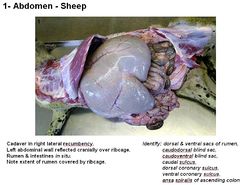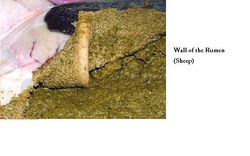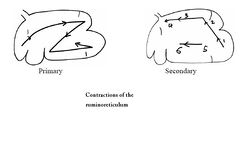Difference between revisions of "Rumen - Anatomy & Physiology"
m (Text replace - "Structure of the Heart - Anatomy & Physiology#" to "Heart Structure - Anatomy & Physiology#") |
|||
| Line 1: | Line 1: | ||
| − | [[Image:Rumen Topography Sheep.jpg|thumb|right| | + | [[Image:Rumen Topography Sheep.jpg|thumb|right|250px|Rumen Topography (Sheep) - Copyright RVC 2008]] |
| + | |||
==Introduction== | ==Introduction== | ||
| − | The rumen is the first chamber of the ruminant stomach. It is the largest chamber and has regular contractions to move food around for digestion, eliminate gases through [[Eructation - Anatomy & Physiology|eructation]] and send food particles back to the mouth for [[Mastication|remastication]]. | + | The rumen is the first chamber of the ruminant stomach. It is the largest chamber and has regular contractions to move food around for digestion, eliminate gases through [[Eructation - Anatomy & Physiology|eructation]] and send food particles back to the mouth for [[Mastication|remastication]]. The rumen breaks down food particles through mechanical digestion and fermentation with the help of symbiotic microbes. [[Volatile Fatty Acids|Volatile fatty acids]] are the main product of ruminant digestion. |
| − | |||
| − | The rumen breaks down food particles through mechanical digestion and fermentation with the help of symbiotic microbes. [[Volatile Fatty Acids|Volatile fatty acids]] are the main product of ruminant digestion. | ||
==Structure== | ==Structure== | ||
| − | [[Image:Rumen Anatomy Sheep.jpg|thumb|right| | + | [[Image:Rumen Anatomy Sheep.jpg|thumb|right|250px|Rumen Anatomy (Sheep) - Copyright RVC 2008]] |
| − | + | Grooves correspond with thickened smooth muscle pillars on the inside of the rumen. '''Ruminal pillars''' divide the dorsal and ventral ruminal sacs. '''Coronary pillars''' divide the caudal blind sacs. The '''cranial pillar''' divides the dorsal and cranial sacs. It is covered by the greater omentum. The rumen is 38-40°C, anaerobic and has a pH of 6.7. It is buffered and has a large holding capacity. Water intake lowers the ruminal temperature so bacteria are tolerant to temperature changes towards the lower end of the scale. Objects are often lodged in the rumino-reticular fold. When the rumen contracts, the object can be pushed through the [[Reticulum - Anatomy & Physiology|reticulum]] wall into the [[Heart Structure - Anatomy & Physiology#Pericardium|pericardium]] and [[Heart - Anatomy & Physiology|heart]]. | |
| − | |||
| − | |||
| − | |||
| − | + | The rumen is laterally compressed and extends from the cardia at the level of the 8th rib to the pelvic inlet. The serosa covers the entire rumen except dorsally where the rumen attaches to the abdominal roof allowing more freedom for ruminal movement and expansion. Ruminal contractions can be felt for in the left paralumbar fossa. 1-2 contractions should be felt per minute. The opening at the cardia into both the rumen and [[Reticulum - Anatomy & Physiology|reticulum]] is called the reticuluar groove (see [[Oesophageal Groove|oesophageal groove]]). | |
| − | |||
| − | |||
| − | |||
| − | |||
| − | |||
| − | |||
| − | |||
| − | |||
| − | |||
| − | |||
| − | |||
| − | |||
| − | |||
| − | |||
| − | |||
| − | |||
| − | |||
| − | |||
| − | |||
| − | |||
| − | |||
| − | |||
| − | |||
| − | |||
| − | |||
| − | |||
==Function== | ==Function== | ||
| − | + | The rumen is involved in waste removal. Simpler products of digestion are assilimated directly, others continue down the digestive tract for further digestion. It mixes food and moves food forwards through the stomach chambers. Sensors in the rumen can determine the courseness of the food. Course, tough feed needs stronger and more frequent ruminal contractions. The '''vagus nerve''' ([[Cranial Nerves - Anatomy & Physiology|CN X]]) is needed for control of stomach movements. The reflex control is through sensory receptors in the medulla. | |
| − | |||
| − | |||
| − | |||
| − | |||
| − | |||
| − | |||
| − | + | See [[Rumination - Anatomy & Physiology|rumination]] and [[Eructation - Anatomy & Physiology|eructation]]. | |
| − | |||
| − | |||
| − | |||
| − | |||
| − | |||
| − | |||
| − | |||
| − | |||
==Ruminoreticular contraction== | ==Ruminoreticular contraction== | ||
| − | [[Image:Contractions of the ruminoreticulum diagram.jpg|thumb|right| | + | [[Image:Contractions of the ruminoreticulum diagram.jpg|thumb|right|250px|Diagram of the contractions of the ruminoreticulum - Copyright RVC 2008]] |
| − | |||
| − | |||
| − | |||
| − | |||
| − | |||
| − | + | The contractions primarily mix food. There is a mixing cycle of the ruminoreticulum. There are 2 contractions of the [[Reticulum - Anatomy & Physiology|reticulum]] (2nd most powerful) which continues over the rumen. The ingesta flows from the [[Reticulum - Anatomy & Physiology|reticulum]] to the cranial ruminal sac to the [[Reticulum - Anatomy & Physiology|reticulum]] (or ventral sac). It occurs every 60 seconds. The secondary contraction lets gas out. (See [[Eructation - Anatomy & Physiology|eructation]]). Ingesta flows from the ventral blind sac to the dorsal blind sac to the dorsal sac ([[Eructation - Anatomy & Physiology|eructation]]) to the ventral sac. | |
| − | |||
| − | |||
==Vasculature== | ==Vasculature== | ||
| − | + | The rumen recieves blood from the '''cranial mesenteric artery''', '''celiac artery''' and '''right''' and '''left ruminal arteries'''. | |
| − | |||
| − | |||
| − | |||
| − | |||
==Innervation== | ==Innervation== | ||
| − | + | The rumen is innervated by the '''dorsal vagus''' nerve ([[Cranial Nerves - Anatomy & Physiology|CN X]]) (most important) and '''ventral vagus''' ([[Cranial Nerves - Anatomy & Physiology|CN X]]) nerve. | |
| − | |||
| − | |||
==Lymphatics== | ==Lymphatics== | ||
| − | + | The caudal '''mediastinal lymph node''' enlargement puts pressure on the dorsal vagus effecting ruminal contractions. There are numerous small lymph nodes scattered in the ruminal grooves. The lymph drains to larger atrial nodes between the cardia and [[Omasum - Anatomy & Physiology|omasum]], then to the cistera chyli. | |
| − | |||
| − | |||
| − | |||
| − | |||
| − | |||
| − | |||
==Rumen Microbes== | ==Rumen Microbes== | ||
| − | + | The rumen has a variety of microbes that can utilise many substrates. The dominance of different bacterial species depends on pH. Ergo, microbial populations are not constant. Microbes digest cellulose and hemi-cellulose and provide a source of all amino acids. Microbes also synthesise vitamins (especially the B vitamins). | |
| − | |||
| − | |||
| − | |||
| − | |||
| − | |||
| − | |||
| − | |||
| − | |||
| − | + | ==Rumen Microbial Population== | |
| − | + | '''Bacteria''' | |
| − | + | There are over 2000 species, 99.5% are obligate anaerobes. | |
| − | |||
| − | + | '''Protozoa''' | |
| − | + | Large, unicellular organisms that prey on bacteria. Numbers are affected by diet. | |
| − | |||
| − | |||
| − | |||
| − | + | '''Fungi''' | |
| − | + | Digest fibre. Numbers present are usually low. | |
| − | |||
'''Common Rumen Microbes''' | '''Common Rumen Microbes''' | ||
| Line 155: | Line 79: | ||
===Small Ruminats=== | ===Small Ruminats=== | ||
| − | |||
| − | + | Sheep and goats have a larger ventral ruminal sac than dorsal ruminal sac. The cranial mesenteric artery and celiac artery come off the same root. | |
===Bovine=== | ===Bovine=== | ||
| − | |||
| − | + | The cranial mesenteric artery and celiac artery are close in the cow. Dairy cows have a rumen pH of 5.5 due to more digestible feed. | |
<br /> | <br /> | ||
<br /> | <br /> | ||
| − | |||
| − | + | ==Links== | |
| − | + | '''Test yourself with the [[The_Stomachs_of_the_Ruminant_-_Anatomy_%26_Physiology_-_Flashcards|Ruminant Stomach Flashcards]]''' | |
| − | [[Reticulum - Anatomy & Physiology| | + | '''Click here for information on [[Reticulum - Anatomy & Physiology|the Reticulum - Anatomy & Physiology]]''' |
| − | [[Omasum - Anatomy & Physiology| | + | '''Click here for information on [[Omasum - Anatomy & Physiology|the Omasum - Anatomy & Physiology]]''' |
| − | [[Abomasum - Anatomy & Physiology| | + | '''Click here for information on [[Abomasum - Anatomy & Physiology|the Abomasum- Anatomy & Physiology]]''' |
| − | '''Video''' | + | '''Video links:''' |
[http://stream2.rvc.ac.uk/Anatomy/bovine/Pot0052.mp4 Pot 52 Lateral view of the Abdomen of a young Ruminant] | [http://stream2.rvc.ac.uk/Anatomy/bovine/Pot0052.mp4 Pot 52 Lateral view of the Abdomen of a young Ruminant] | ||
| Line 192: | Line 113: | ||
[[Category:Stomach - Anatomy & Physiology]] | [[Category:Stomach - Anatomy & Physiology]] | ||
| − | [[Category:To Do - | + | [[Category:To Do - AimeeHicks]] |
Revision as of 11:59, 15 September 2010
Introduction
The rumen is the first chamber of the ruminant stomach. It is the largest chamber and has regular contractions to move food around for digestion, eliminate gases through eructation and send food particles back to the mouth for remastication. The rumen breaks down food particles through mechanical digestion and fermentation with the help of symbiotic microbes. Volatile fatty acids are the main product of ruminant digestion.
Structure
Grooves correspond with thickened smooth muscle pillars on the inside of the rumen. Ruminal pillars divide the dorsal and ventral ruminal sacs. Coronary pillars divide the caudal blind sacs. The cranial pillar divides the dorsal and cranial sacs. It is covered by the greater omentum. The rumen is 38-40°C, anaerobic and has a pH of 6.7. It is buffered and has a large holding capacity. Water intake lowers the ruminal temperature so bacteria are tolerant to temperature changes towards the lower end of the scale. Objects are often lodged in the rumino-reticular fold. When the rumen contracts, the object can be pushed through the reticulum wall into the pericardium and heart.
The rumen is laterally compressed and extends from the cardia at the level of the 8th rib to the pelvic inlet. The serosa covers the entire rumen except dorsally where the rumen attaches to the abdominal roof allowing more freedom for ruminal movement and expansion. Ruminal contractions can be felt for in the left paralumbar fossa. 1-2 contractions should be felt per minute. The opening at the cardia into both the rumen and reticulum is called the reticuluar groove (see oesophageal groove).
Function
The rumen is involved in waste removal. Simpler products of digestion are assilimated directly, others continue down the digestive tract for further digestion. It mixes food and moves food forwards through the stomach chambers. Sensors in the rumen can determine the courseness of the food. Course, tough feed needs stronger and more frequent ruminal contractions. The vagus nerve (CN X) is needed for control of stomach movements. The reflex control is through sensory receptors in the medulla.
See rumination and eructation.
Ruminoreticular contraction
The contractions primarily mix food. There is a mixing cycle of the ruminoreticulum. There are 2 contractions of the reticulum (2nd most powerful) which continues over the rumen. The ingesta flows from the reticulum to the cranial ruminal sac to the reticulum (or ventral sac). It occurs every 60 seconds. The secondary contraction lets gas out. (See eructation). Ingesta flows from the ventral blind sac to the dorsal blind sac to the dorsal sac (eructation) to the ventral sac.
Vasculature
The rumen recieves blood from the cranial mesenteric artery, celiac artery and right and left ruminal arteries.
Innervation
The rumen is innervated by the dorsal vagus nerve (CN X) (most important) and ventral vagus (CN X) nerve.
Lymphatics
The caudal mediastinal lymph node enlargement puts pressure on the dorsal vagus effecting ruminal contractions. There are numerous small lymph nodes scattered in the ruminal grooves. The lymph drains to larger atrial nodes between the cardia and omasum, then to the cistera chyli.
Rumen Microbes
The rumen has a variety of microbes that can utilise many substrates. The dominance of different bacterial species depends on pH. Ergo, microbial populations are not constant. Microbes digest cellulose and hemi-cellulose and provide a source of all amino acids. Microbes also synthesise vitamins (especially the B vitamins).
Rumen Microbial Population
Bacteria There are over 2000 species, 99.5% are obligate anaerobes.
Protozoa Large, unicellular organisms that prey on bacteria. Numbers are affected by diet.
Fungi Digest fibre. Numbers present are usually low.
Common Rumen Microbes
| Species | Type | pH |
|---|---|---|
| Ruminococcus flavefauens | Fibre | 6.15 |
| Fibrobacter succinogens | Fibre | 6 |
| Megashpaera eisdeni | Lactate user | 4.9 |
| Streptococcus bovis | Lactate producer | 4.55 |
Species Differences
Small Ruminats
Sheep and goats have a larger ventral ruminal sac than dorsal ruminal sac. The cranial mesenteric artery and celiac artery come off the same root.
Bovine
The cranial mesenteric artery and celiac artery are close in the cow. Dairy cows have a rumen pH of 5.5 due to more digestible feed.
Links
Test yourself with the Ruminant Stomach Flashcards
Click here for information on the Reticulum - Anatomy & Physiology
Click here for information on the Omasum - Anatomy & Physiology
Click here for information on the Abomasum- Anatomy & Physiology
Video links:
Pot 52 Lateral view of the Abdomen of a young Ruminant
Pot 175 Sections of the Ruminant Stomach
Left sided topography of the Ovine Abdomen and Thorax


